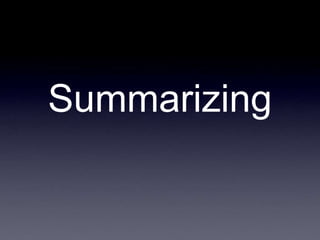
Summarizing powerpoint
- 1. Summarizing
- 2. Summarizing is a powerful reading strategy. It increases comprehension and retention of information.
- 3. When you summarize, you restate the most important information of a text, using your own words.
- 4. A summary can be completed in writing, but also orally, dramatically, artistically, visually, physically or musically.
- 6. Keeping Keep only the important information and main ideas.
- 7. Deleting Do not include supporting details in your summary.
- 8. Paraphrasing Use your own words!!!
- 9. “Summaries are about the author’s arguments and details; they are not the place for personal opinions or judgments.” -- Rick Wormeli
- 10. Summaries should be between 10 to 25 percent of the original text’s length (1 percent for novels).
- 11. If the summary is more than 25% of the original text’s length, you need to delete more details and keep only the important information.
- 12. One of the toughest parts of summarizing, is paraphrasing -- putting important information into your own words.
- 13. Let’s give paraphrasing a try. Read the passage on the next slide. You will be asked to paraphrase afterwards, so be sure you are comprehending as you read !!
- 14. People used to play football bareheaded. After many injuries, players began to use plain, leather caps. Plastic helmets and masks appeared later. Still, many players were getting hurt. To make helmets better, designers studied --- woodpeckers! Their tough, spongy skulls became the model for modern football helmets.
- 15. Now, summarize the text from the previous slide either in writing or orally. Remember to paraphrase. If you follow our 10% to 25% rule, your summary should only be a few sentences.
- 16. Here is an example of a summary for the passage you read. During football’s early days, many injuries occurred due to little or no head protection. Improved football helmets were designed using woodpecker skulls as a
- 17. Your summary and paraphrase will not be exactly the same as the example shown. However, it should include the following important details.
- 18. •Football was originally played with little or no head protection •Injuries occurred •Improved helmets/head protection were modeled after woodpecker skulls
- 19. Summarizing Tricks Let’s look at some strategies/tricks that will help you summarize.
- 20. •Text Features •Vocabulary •Topic Sentences •Reporter’s Notes -- Who, What, Where, Wh en, Why, How •Organizers
- 21. Text Features Text features such as titles, subtitles, bold, color, margin notes, etc. are clues to a text’s most important information -- information you may want to include in your summary.
- 22. Vocabulary If a text gives you a list of important vocabulary in it’s preview, or your teacher provides vocabulary prior to a unit of study, use these vocabulary words as important information that should be included in your summary.
- 23. Topic Sentence When reading a short text, identify the topic sentence in each paragraph. A topic sentence holds the most important information in a paragraph. Therefore, a summary can be written simply by paraphrasing the topic sentences into your own words.
- 24. Reporter’s Notes Who? What? Where? When? Why? How? Identify the answer to each of the above items. Take your answers, write them into paragraph form and you have the framework for your summary.
- 25. Organizers The following slides show examples of organizers that will assist you with summarizing. You can also find these organizers on Ms. McAllister’s SWIFT website under documents - organizers.
- 29. Remember, summarizing is a powerful tool to help you understand and remember what you read.
- 30. • Beech, Linda Ward, et. al. Comprehension Skills - Main Idea - Level F. Austin, Texas: Steck-Vaughn Company, 1992. • Burke, Jim. Reading Reminders: Tools, Tips, and Techniques. Portsmouth, NH: Boynton/Cook Publishers, 2000. • Burke, Jim. Tools for Thoughts. Portsmouth, NH: Boynton/Cook Publishers, 2002. • Crain, Hilary, et. al. The Write Path: Teacher Guide for English Language Arts, Middle Level through High School. AVID Press, 2002. • Wormeli, Rick. Summarizing in any Subject: 50 Techniques to Improve Student Learning. Alexandria, Virginia: ASCD, 2005. Bibliography